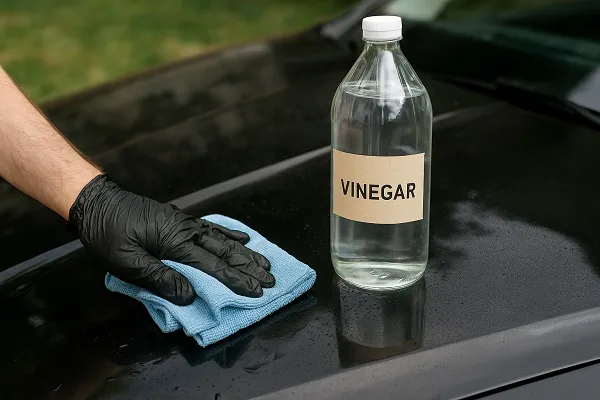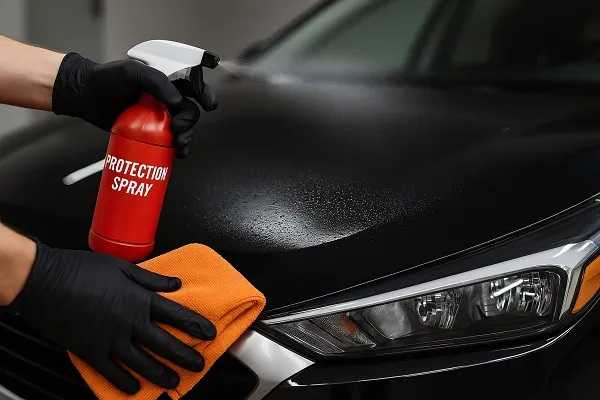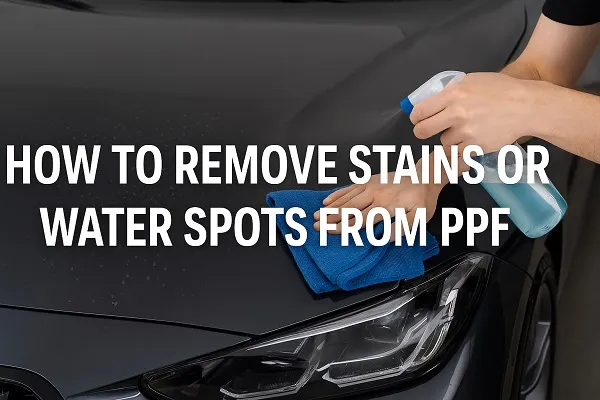Paint protection film (PPF) is designed to shield your vehicle’s paint from scratches, chips, and environmental damage. However, over time, water spots and stains can form on the surface. Knowing how to remove stains or water spots from PPF the right way will help you maintain a spotless, glossy finish and extend the life of your film.
Why Water Spots Form on PPF
Water spots usually come from minerals left behind after water evaporates. Hard water, acid rain, road grime, or even sprinkler overspray can etch into the PPF if left untreated. While the film itself resists damage, minerals and contaminants can bond to the surface, making cleaning more challenging.
Safe Cleaning Methods for Stains and Water Spots
Not all cleaning methods are safe for PPF. Harsh chemicals or abrasive techniques can damage the top coat. Stick to proven techniques that are both effective and safe for the film.
Gentle Wash First
- Start with a pH-neutral car shampoo.
- Use a soft microfiber wash mitt to avoid scratching.
- Rinse thoroughly with filtered water when possible.
This step removes surface dirt so you can focus on the actual water spots.
Using Vinegar for Mineral Deposits

White vinegar is one of the safest ways to remove light water spots from PPF.
Steps:
- Mix equal parts distilled water and white vinegar in a spray bottle.
- Spray the solution directly onto the affected area.
- Let it dwell for 2–3 minutes (do not let it dry).
- Wipe with a clean microfiber towel.
- Rinse with fresh water and dry.
This works because vinegar breaks down the mineral deposits without harming the film’s surface.
Specialty Water Spot Removers
When vinegar isn’t enough, dedicated water spot removers formulated for PPF and automotive surfaces are available.
What to look for in a product:
- Safe for urethane-based films
- Non-abrasive
- Acid-free or mild acid-based for mineral breakdown
Application tips:
- Always test on a small, inconspicuous area first.
- Use a soft microfiber applicator pad.
- Follow with a rinse to remove chemical residue.
Dealing With Stubborn or Etched Stains
Sometimes, minerals can etch into the PPF’s top coat, leaving faint marks even after cleaning.
Advanced options include:
- Clay bar treatment: Removes bonded contaminants. Use only a fine-grade clay with plenty of lubrication.
- Polishing PPF: A professional may use very mild polish designed for PPF to restore clarity.
- Film replacement: If stains are severe and etched deeply, replacing the section of film may be the only option.
Preventing Water Spots and Stains on PPF

Prevention is easier than correction. Following these habits helps you avoid the problem altogether.
Drying Techniques
- Always dry your car after washing—don’t air dry.
- Use a high-quality drying towel or blower.
Protective Coatings
- Ceramic coating on top of PPF can add hydrophobic protection, making water bead and roll off.
- Sealants specifically formulated for PPF also help reduce spotting.
Maintenance Habits
- Wash regularly to prevent buildup.
- Avoid parking near sprinklers or under trees that drip sap.
- Use filtered or deionized water when rinsing.
Professional Help
If you’ve tried DIY methods without success, a professional PPF installer or detailer can safely address the issue. They have access to advanced tools, polishes, and film-safe techniques that go beyond household remedies.
Keeping your paint protection film free from stains and water spots is essential to maintaining its clarity and protective qualities. By using safe cleaning methods like vinegar, dedicated water spot removers, and preventive care such as ceramic coatings, you can extend the life and appearance of your PPF. Regular maintenance not only preserves the film’s look but also ensures your vehicle’s paint remains in pristine condition.

